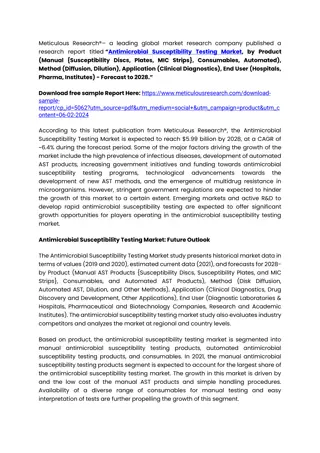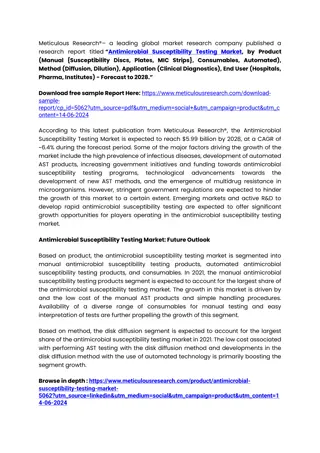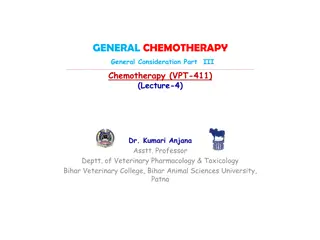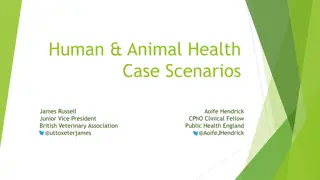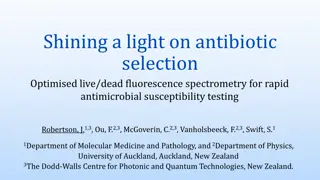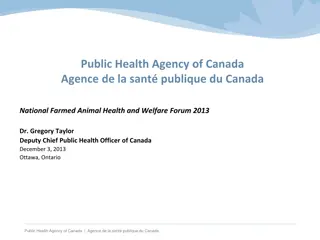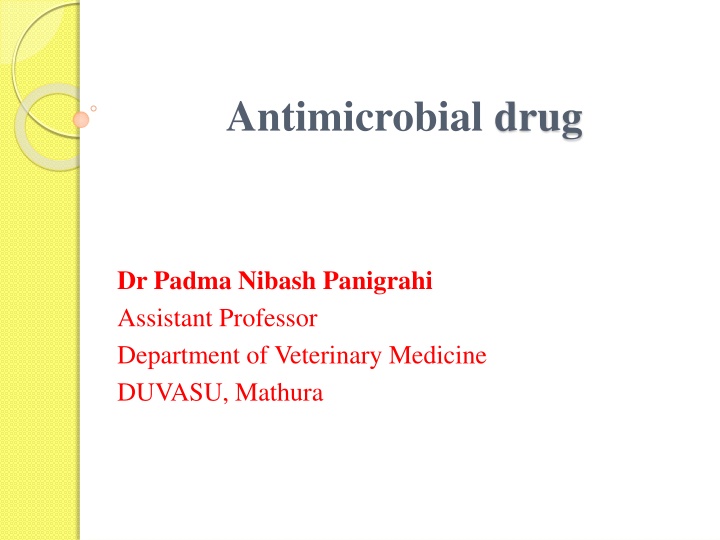
Antimicrobial Drug Classification and Mechanisms of Action
Explore the classification of antimicrobial drugs, including bacteriocidal and bacteriostatic types, and their mechanisms of action such as inhibiting cell wall synthesis, protein synthesis, and nucleic acid synthesis. Discover common antimicrobial agents like penicillins and aminoglycosides, along with their indications and adverse effects.
Download Presentation

Please find below an Image/Link to download the presentation.
The content on the website is provided AS IS for your information and personal use only. It may not be sold, licensed, or shared on other websites without obtaining consent from the author. If you encounter any issues during the download, it is possible that the publisher has removed the file from their server.
You are allowed to download the files provided on this website for personal or commercial use, subject to the condition that they are used lawfully. All files are the property of their respective owners.
The content on the website is provided AS IS for your information and personal use only. It may not be sold, licensed, or shared on other websites without obtaining consent from the author.
E N D
Presentation Transcript
Antimicrobial drug Dr Padma Nibash Panigrahi Assistant Professor Department of Veterinary Medicine DUVASU, Mathura
Introduction Anti bacterial Antifungal Antirickettsial Antiviral Factors Age, sex, species Route Organ system affected Cost
Classification Bacteriocidal Bacteriostatic Narrow-spectrum antimicrobial Broad-spectrum antimicrobial: kill wide range of microorganisms:
Bactericidal Bacteriostatic -lactam agents Aminoglycosides Quinolones Vancomycin Sulfonamides Erythromycin Tetracyclines Chloramphenicol Trimethoprim
Classification-MOA 1. Inhibit cell wall synthesis 2. Inhibit protein synthesis 3. Inhibit nucleic acid synthesis 4. Injury to plasma membrane 5. Inhibit synthesis of essential metabolites
1. Inhibit cell wall synthesis Eg- -Lactam Drugs : penicillins and cephalosporins gr. Irreversibly inhibit enzymes involved in the final steps of cell wall synthesis
Penicillin Natural penicillin: penicillin G and V Penicillinase-resistant penicillins: cloxacillin, dicloxacillin, oxacillin, and methicillin (narrow spetrum) Aminopenicillins : ampicillin, amoxicillin, cyclacillin, hetacillin and bacampicillin Extended-spectrum penicillin : carbenicillin, piperacillin Potentiated penicillin : amoxicillin- potassium clavulanate, ampicillin-sulbactam, and ticarcillin-potassium clavulanate
Indicaion : aerobic and anaerobic G + bacilli - Bacillus anthracis, Clostridium sp. (not C. difficile), Fusobacterium and Actinomyces Aminopenicillins: broad-spectrum- gram negative aerobes (E. coli, Klebsiella, and Haemophilus) + G+ve Contraindicated- in patients having history of hypersensitivity Adverse reaction- very low, If given orally may cause GI effects (anorexia, vomiting, diarrhea). Because may also alter gut flora, antibiotic- associated diarrhea Safe in pregnancy
High doses or very prolonged use has been associated with neurotoxicity Drug interaction: Synergistic with aminoglycosides or cephalosporins, beta-lactamase inhibitors- clavulanic acid, sulbactam, tazobactam Antagonistic: with bacteriostatic antibiotics (e.g., chloramphenicol, erythromycin, tetracyclines) Ampicillin may cause false-positive urine glucose determinations when using cupric sulfate solution (Benedicts Solution) Probenecid competitively blocks the tubular secretion of most penicillins
cephalosporins INHIBITORS OF CELL WALL SYNTHESIS -LASTAMASE INHIBITORS -LASTAMASE ANTIBIOTIC OTHER ANTIBIOTIC Bacitracin Vancomycin Clavulanic acid Sulbactam Tazobactam CARBAPENEMS Imipenem/cilastatin Meropenem* Ertapenem MONOBACTAMS PENICILLINS CEPHALOSPORINS Amoxicillin Ampicillin Cloxacillin Dicloxacillin Indanyl carbenicillin Methicillin Nafcillin Oxacillin Penicillin G Penicillin V Piperacillin Ticarcillin Aztreonam 3rd GENERATION 4th GENERATION 1st GENERATION 2nd GENERATION Cefadroxil Cefazolin Cephalexin Cephalothin Cefaclor Cefamandole Cefprozil Cefuroxime Cefotetan Cefoxitin Cefdinir Cefixime Cefoperazone Cefotaxime Ceftazidime Ceftibuten Ceftizoxime Ceftriaxone Cefepime (according to Lippincott s Pharmacology, 2009)
Cephalosporins Indication: both G +ve and ve Contraindicated- in patients having history of hypersensitivity Safe in pregnancy Adverse reaction- very low, If given orally may cause GI effects (anorexia, vomiting, diarrhea). Because may also alter gut flora, antibiotic-associated diarrhea
Drug interaction: Synergistic with aminoglycosides or cephalosporins, beta-lactamase inhibitors- clavulanic acid, sulbactam, tazobactam Antagonistic: use of parenteral aminoglycosides or other nephrotoxic drugs (e.g., amphotericin B) with cephalosporins could cause additive nephrotoxicity
Ceftriazone- @ 5- 10 mg/kg- L A @ 15-25 mg/kg- dog, cat, (IM, IV, PO) Cefotaxim @ 25-50 mg/kg- dog, cat Caftiofur @ 1.1- 2.2 mg/kg- IM, SC Cefadroxil @ 10-30 mg/kg- PO
2. Inhibit Protein Synthesis Target ribosomes of bacteria Aminoglycosides: bind to 30S subunit causing it to distort and malfunction; blocks initiation of translation Tetracyclines: bind to 30S subunit blocking attachment of tRNA. Macrolides: bind 50S subunit and prevents protein synthesis from continuing.
Aminoglyosides Amikacin @ 10 mg/kg- dog, cat, tid, IM,IV,SC Gentamicin @ 4 mg/kg- C/ S/G/D/C/P- IM,IV, poultry- 3-5 mg/kg Neomycin Netilmicin Streptomycin- sreptopenicillin Tobramycin Contraindicated-in pregnancy and cow prone to milk fever
Indication Bacterisidal many aerobic G-ve and some aerobic gram positive bacteria, including most species of E. coli, Klebsiella, Proteus, Pseudomonas, Salmonella, Enterobacter, Serratia, and Shigella, Mycoplasma, and Staphylococcus. Several strains of Pseudomonas aeruginosa, Proteus, and Serratia that are resistant to gentamicin will still be killed by amikacin. Antimicrobial activity of the aminoglycosides are enhanced in an alkaline environment. The aminoglycoside antibiotics are inactive against fungi, and most anaerobic bacteria
Toxicity- irreversible ototoxicity and nephrotoxic caution in patients with neuromuscular disorders (e.g., myasthenia gravis) due to their neuromuscular blocking activity. Contraindicated- in pregnancy and cow prone to milk fever in rabbits/hares as they adversely affect the GI flora balance in these animals Drug Interactions - used with caution with other nephrotoxic, ototoxic, and neurotoxic drugs. These include amphotericin B, other aminoglycosides, acyclovir, bacitracin (parenteral use), cisplatin, methoxyflurane, polymyxin B, or vancomycin.
Tetracyclines OTC @ 5- 10 mg/kg LA @ 10-20 mg/kg dog, cat, IM,IV Doxicycline @10 mg/kg dog, cat @ 1-2 mg/kg cattle, S, G, PO Bacteriostatic Indication G +ve, G ve, Clamydia, Rickettsia, Mycoplasma
Contraindicated- young animal and pregnant young animals can cause discoloration of bones and teeth to a yellow, brown, or gray colour. Only used in the last trimester of pregnancy Cats do not tolerate oral tetracycline Toxicity Nephrotoxic and hepatotoxic long term use
Macrolides erythromycin, roxithromycin, azithromycin, clarithromycin (methylated form of erythrom.) telithromycin - derivative of erythromycin (a ketolide) , clindamycin Indication- gram positive cocci (staphylococci, streptococci), gram positive bacilli, some strains of gram negative bacilli Actinomyces, Mycoplasma, Chlamydia, Ureaplasma, and Rickettsia are
Erythromycin Erythromycin (base) capsules and tablets should be stored in tight containers at room temperature protected from light. To retain palatability, the oral suspensions should be refrigerated. @ 2.2-4.4 mg/kg- LA, PO @10-40 mg/ kg dog
Drug Interactions Because erythromycin, lincosamides (clindamycin, lincomycin), and chloramphenicol all bind to the 50S ribosomal subunit, competition for binding can occur and some clinicians state these drugs should not be used concurrently. In vitro synergy with other antimicrobials (e.g., sulfonamides, rifampin) has been reported with erythromycin Drug/Laboratory Interactions - Erythromycin may cause falsely elevated values of AST (SGOT), and ALT (SGPT) when using colorimetric assays. Fluorometric determinations of urinary catecholamines can be altered by concomitant erythromycin administration.
Clindamycin Lincosamide antibotics 50 s ribosome @ 5.5 mg/ kg BID, PO/ 11 mg/kg OD Avoid in rabbit, Guinea pig and hamster because of serious gastrointestinal effects that may occur, including death Contraindicated during pregnancy and lactation- diarrhoea in newborn
Cloramphenicol Broad-spectrum wide range of G+ and gram organisms; also some intracellular - e.g. rickettsiae. mostly bacteriostatic Should be used with caution in neonatal animals, particularly in young kittens. In neonates (humans), circulatory collapse (Gray- baby syndrome) has occurred probably due to toxic levels accumulating secondary to an inability to conjugate
given with caution to nursing bitches or queens, particularly within the first week after giving birth- excrete in milk Serious side-effects: bone marrow aplasia, suppression of RBCs, WBCs, encephalopathy, optic neuritis
3. Inhibit Nucleic Acid Synthesis Target enzymes required for nucleic acid synthesis Fluoroquinolones: inhibit enzymes DNA gyrase that maintain the supercoiling of closed circular DNA, bacteriidal Rifamycins: block prokaryotic DNA- dependent RNA polymerase from initiating transcription
Fluoroquinolones Enrofloxacin@ 2.5-5 mg/kg, IM,IV,PO Ciprofloxacin @ 5- 15 (Dog, Cat), 5 mg/kg LA, Norfloxacin Levofloxacin Nalidixic acid @ 50 mg/ kg /day-divided dose- dog, PO (UTI) Gatifloxacin- ointment (eye drop)
Enrofloxacin Bactericidal Mostly G ve Contraindications young animals Arthropathic effect GI and CNS defect Rashes in skin Not recommended in horse Quinolones are also contraindicated in patients hypersensitive to them.
Ciprofloxacin ciprofloxacin has occasionally been reported to cause crystalluria, animals should not be allowed to become dehydrated during therapy with either ciprofloxacin or enrofloxacin. In humans, ciprofloxacin has been associated with CNS stimulation and should be used with caution in patients with seizure disorders. Patients with severe renal or hepatic impairment may require dosage adjustments to prevent drug accumulation.
4. Sulphonamides Sulfonamides (Sulfa drugs) Inhibit folic acid synthesis Broad spectrum Bacteriostatic
Contraindications patients hypersensitive to them, thiazides, or sulfonylurea agents. patients with severe renal or hepatic impairment and should be used with caution in patients with diminished renal or hepatic function, or urinary obstruction. Oral sulfonamides can depress the normal cellulytic function of the ruminoreticulum, but this effect is generally temporary and the animal adapts. Sulfas cross the placenta and teratogenicity has been reported in some laboratory animals when given at very high doses. They should be used in pregnant animals only when the benefits clearly outweigh the risks of therapy.
Drug Interactions - Sulfonamides may displace other highly bound drugs, such phenylbutazone, thiazide diuretics, salicylates, probenicid and phenytoin Synergestic Trimethoprim
5. Injure Plasma Membrane Polymyxin B: binds to membrane of G- ve bacteria Alters permeability of cell membrane leads to leakage of cellular contents and cell death These drugs also bind to eukaryotic cells to some extent, which limits their use to topical applications @2.2 mg (10000 unit)/kg/day-divided dose Nephrotoxic-prolonged use

